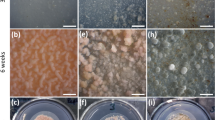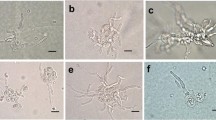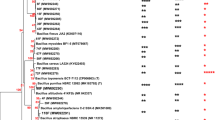Abstract.
Immobilized lichen cells from the thalli of the lichen Pseudevernia furfuracea, supplied with acetate as the only source of carbon, continuously produced phenolic substances, atranorin and physodic acid, over 23 days. Epiphytic bacteria associated with the lichen thallus grew actively, probably using both acetate and reduced compounds supplied by lichen cells, since their active growth was avoided by including 10 µM 3,3′-dichlorophenyl-1,1′dimethylurea in the bath solution. Penicillin largely impeded the growth of epiphytic bacteria and decreased phenolic production, which was recovered only at the end of the experimental period, just when the bacteria started a slow, but active growth. We suggest the cooperation of epiphytic bacteria in the biosynthesis of both atranotrin and physodic acid.
Similar content being viewed by others
Author information
Authors and Affiliations
Additional information
Electronic Publication
Rights and permissions
About this article
Cite this article
Blanch, M., Blanco, Y., Fontaniella, B. et al. Production of phenolics by immobilized cells of the lichen Pseudevernia furfuracea: the role of epiphytic bacteria. Int Microbiol 4, 89–92 (2001). https://doi.org/10.1007/s101230100019
Received:
Accepted:
Issue Date:
DOI: https://doi.org/10.1007/s101230100019




